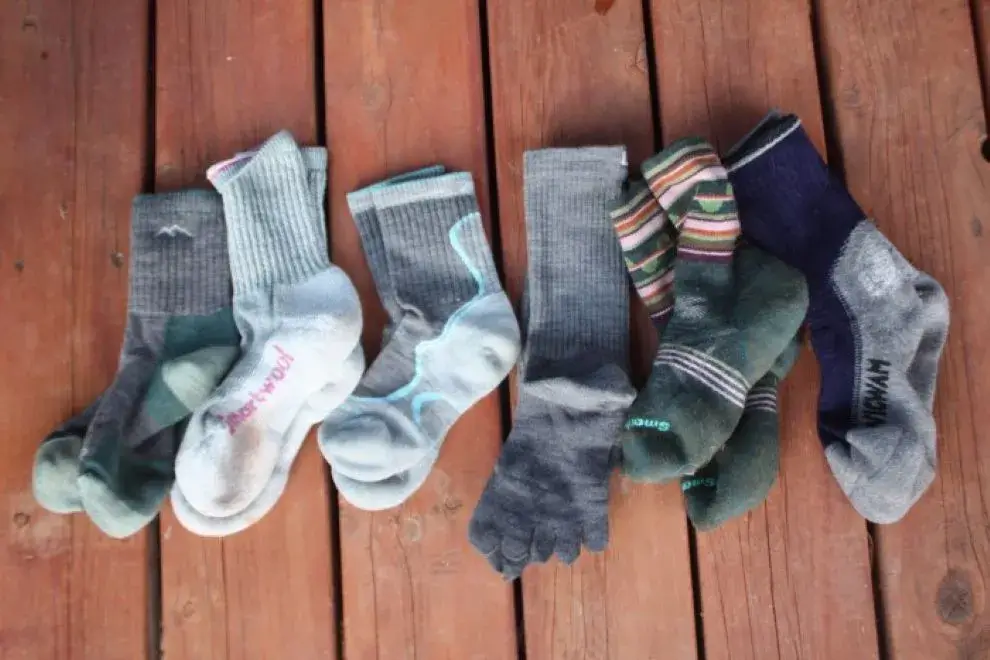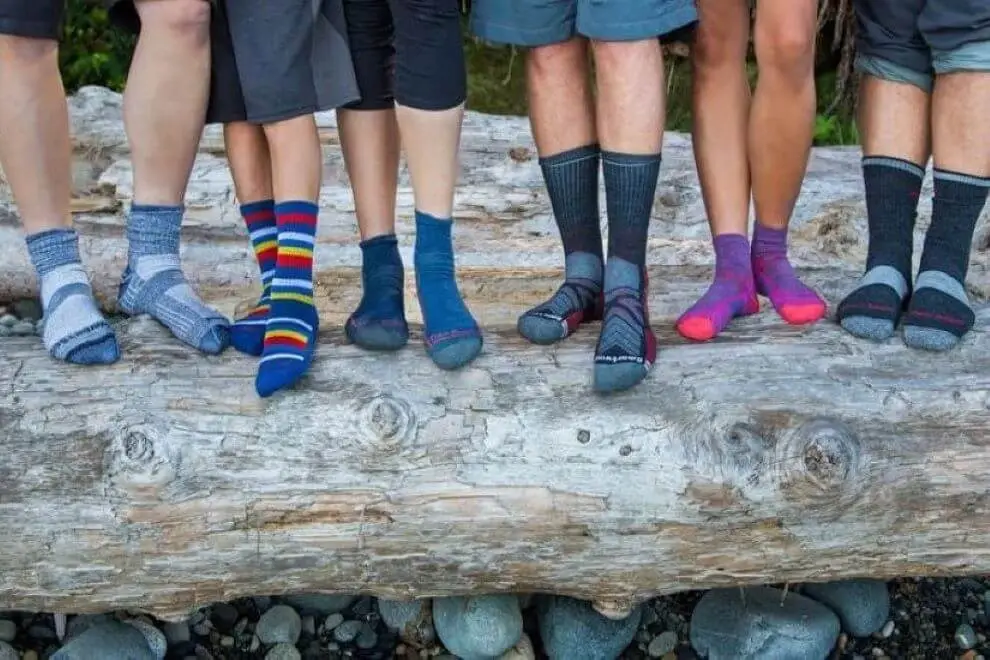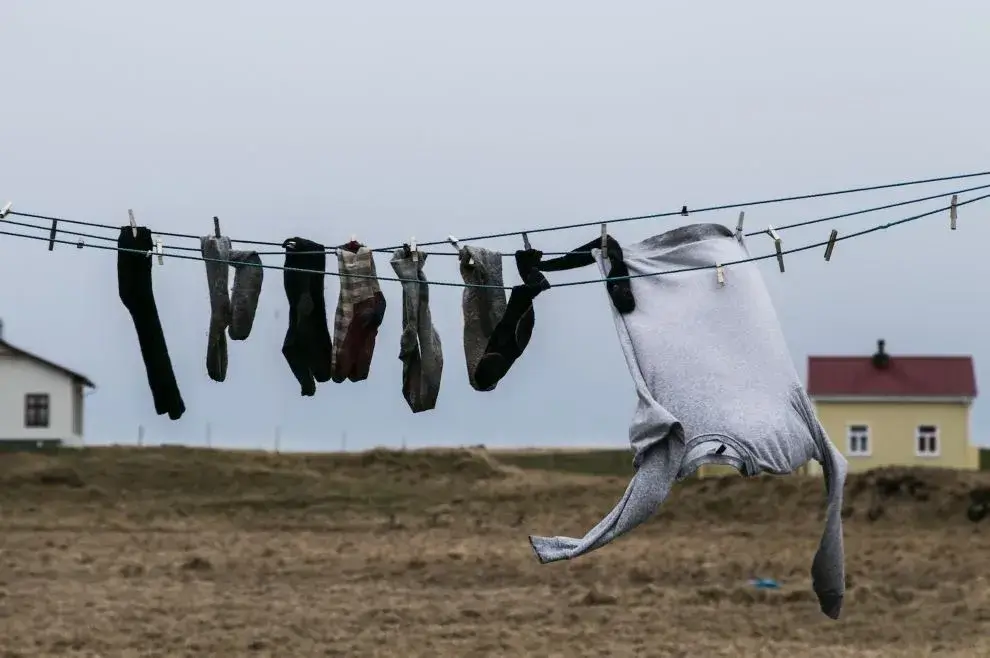Introduction
If you’re the same as me, you probably enjoy spending time outdoors hiking through the mountains or just taking a leisurely weekend stroll. And if you’re like me, you know that there’s nothing quite as annoying as having sore and blistered feet by the end of the day. Well, believe it or not, one of the main reasons for this is that most people don’t wear the proper footwear for hiking – namely, hiking socks!
I faced many problems in my hiking journey when I used regular socks. I collaborate with some experienced hikers. Then they suggested me to buy a pair of hiking socks. Then I decided to make a change in my hiking gear. I decided to invest in a pair of hiking socks to see why are hiking socks necessary. With my three years of experience with hiking, I will talk about some best hiking socks for you.
What are hiking socks, and what do they do?
Hiking socks are made with wool and particular fabric designed to trap air pockets to provide insulation, wick away sweat, and keep your feet dry. Wool is a natural fiber known to wick moisture away from the skin. It also has a natural antimicrobial property, which means that it can help to prevent the growth of bacteria.
Besides providing extra cushioning in the heel and ball, hiking socks also provide additional ventilation. Other materials that are commonly used in hiking socks include nylon and polyester. The fabric is also durable, so it can withstand the abuse your feet will take when hiking.
Difference Between Hiking Socks and Regular Socks
There are many differences between Hiking socks and Normal Socks. In addition, hiking socks are more expensive and specialized than regular socks for hikers. Some significant differences in Cushioning, Wicking, Insulation, Strength, Compression, and Cost are explained below. So keep reading to know why are hiking socks necessary for hiking.

The Cushion
Cushions are designed into hiking socks to provide comfort where it’s needed most – at the ball of the foot, at the toe, and at the heel. The cushioned area is noticeable; when you look at it, you will see a different color. Furthermore, hiking socks have a very dense weave, which adds additional cushioning. Unfortunately, the loose weave spread apart in the old-style wool socks, and holes appeared quickly.
Because you are going to be walking on rough terrain, and you are going to need extra cushions to protect your feet. Regular socks do not have this cushion, leading to pain and blisters. To ensure your feet are protected while hiking, you must invest in good hiking socks.
Wicking
Wicking is one of the critical differences between hiking socks and regular socks. When hiking or exploring other outdoor environments, hiking socks feature high-quality Merino wool to keep your feet dry and comfortable. Although there are other types of wool, Merino wool is soft and dense (named after the breed of sheep from which it comes).
As a result, Merino wool is an excellent moisture-wicking material. On the other hand, regular socks tend to hold sweat against the skin, leaving you feeling clammy and uncomfortable. They also feature patterns of layered threads that facilitate faster drying because hiking socks are made with special materials that dissipate moisture quickly.
Insulation
A standard pair of socks are made of cotton or a cotton blend, which absorbs moisture and provides little insulation. However, hiking socks are designed specifically for outdoor activities and offer several advantages over regular socks. You can even wear socks with sandals and get some of the insulation benefits, Although most consider socks with sandals a faux pas.
Overall, hiking socks provide much better insulation than regular socks and can help you stay warm and comfortable during your next hiking trip. You can even wear socks with sandals and get some insulation benefits.
Strength
Hiking socks offer more support and protection than your average Pair of socks. The design of the socks has compound benefits. Unlike regular socks, hiking socks are typically thicker and more durable materials like wool or synthetic fibers. I can attest that they do last a long time and can endure regular use and abuse.
I have a pair of Darn Tough hiking socks that I wear almost every day. I have been using it for one year+ and saw nothing big changes to it. I am impressed with its strength.
Compression
As I use and have experience with Darn Tough hiking socks, It has a well-fitting and tight fit. They typically have Lycra and nylon integrated into the weave to help with elasticity. As a result, they conform to your foot and leg quite nicely. It not only helps reduce friction and, therefore, blisters but also helps with blood flow in your legs.
Generally, hiking socks are not medical-grade compression socks, but a well-fitting will help somewhat and can keep your legs from tiring quickly. The sock must cover all or almost all of your calf to get a true benefit from compression.
Cost
The cost of hiking socks is usually a little bit more than regular socks, typically in the price range of $20.00-$30.00, but they are worth the investment. To get more extra benefits and enjoy your hiking journey, you should invest something more than others. Investing in good hiking socks is essential if you’re planning for long miles hiking and carrying a heavy pack.
My DARN TOUGH sock’s cost was $24. I bought it from Amazon. You will see more socks with different brands there, like (Merino Wool Hiking Crew, Smartwool Performance Hike, Balega Hidden Comfort, Swift wick Flite XT Trail, and more). It would be best to buy what you like most and what fits you most.
Different types of hiking socks
Different types of hiking socks are made for different types of terrain. For example, some socks are designed for hiking on flat surfaces, and some for hiking on rough terrain. Hiking on uneven terrain can be very tough on your feet, and it can cause blisters to form. Therefore, it is essential to know what sort of terrain you will be hiking in so you can wear the right socks.

There are different materials used in their construction, and this can affect their performance. Some hikers prefer a particular type of sock material for various reasons. For instance, those hiking in hot weather may choose cotton socks because they are breathable and help keep the feet cool. On the other hand, those hiking in cold weather may prefer wool socks because they are insulated and help keep the feet warm.
The most popular Socks brands for Hikers
Several well-known and trusted brands are popular to go hiking with. Brands that include Smartwool, Darn Tough, Sockwell, and WRIGHTSOCK are among the most popular. In the following paragraphs, I describe each brand’s different features of these socks.
Darn Tough Hiker Boot Full-Cushion Socks
Darn Tough Hiker Boot Full-Cushion Socks are perfect for hiking and outdoor activities. They are made with a merino wool blend that is soft, comfortable, and moisture-wicking. The socks have a full cushion on the bottom for added comfort and protection.

The socks are also reinforced in the heel and toe for added durability. The Darn Tough Hiker Boot Full-Cushion Socks are available in various sizes and colors.
Smartwool Performance Hike Light Cushion Crew Socks

Smartwool’s Performance Hike Light Cushion Crew Socks are the perfect choice for hikers looking for a lightweight sock with cushioning. The socks are made with merino wool, nylon, and elastane which is known for its natural odor resistance and breathability. The socks also have a flat knit toe seam to reduce chafing.
Sockwell Circulator Compression Socks
No matter if you are planning a leisurely recovery day or a long-distance trip, your legs deserve the strength of a compression sock. Compression socks can decrease swelling and increase blood flow by gradually applying pressure from the Achilles to the calf.

To maximize circulation, the Sockwell Circulator has graduated compression that increases at the ankles and decreases at the calves (15-20 mmHg). You can use this to reduce recovery time during training and reduce leg swelling during long periods of sitting in an office chair or on a plane.
WRIGHTSOCK Escape Crew Socks
The WRIGHTSOCK Escape Crew has two layers that work together to limit friction caused by repetitive motion. The ultrathin inner layer fits snugly so that it is difficult to pinch loose; your bare skin will be protected from bunching, chafing, and creases. (It also helps wick moisture like a dream to keep your feet dry.) The outer layer cushions your foot like a standard sock while absorbing any rubbing from your shoe as it slides (friction-free) over the inner layer.

These brands offer a variety of sock styles for varying conditions and hiking activities, from lightweight merino wool options ideal for warm weather treks to thermal wool socks great for winter expeditions. So whether you’re looking for cushioning in your soles or special sweat-wicking properties in your fabric. There is sure to be a quality Socks brand that can deliver the comfort and performance you need on the trail.
What is the best way to make hiking socks last longer?
That Pair of socks I mentioned earlier, I am using that Darn Tough socks for one year+. I wear those socks almost every day and whenever I need to wear socks. I use them to go out of the home. When I feel cold, I use them. In case of heat, I use them. While playing, I use them. They are used while I drive. Every time I wear them, they make me feel great. Because I feel comfortable with them, imagine if I wear them only while hiking – those socks probably will last more than two years.
To make your hiking socks last longer, you should avoid washing them in a washing machine. Instead, it would be best if you hand wash them with cold water and mild detergent. You should also avoid drying them in the dryer, as this can cause them to shrink and wear out prematurely. Instead, for any wool item, the best way to dry them is by just air drying. I hope this will help you to make your hiking socks last longer.

The best hiking socks are quick-drying
Hiking socks can dry quickly, which is essential when you are hiking. If your socks are wet, it is going to make your feet feel uncomfortable, and it is going to make it harder for you to hike. It is imperative to wear moisture-wicking and quick-drying clothing when backpacking because mountain weather can change quickly, from sunny skies to rainstorms.
So on those days when you get stuck in the rain, it is of the utmost importance to have the quick-drying gear, so you are not soaked for your next day of hiking. Also, since your feet are stuck in a boot whenever you are hiking, it is even more important that your socks are quickly dry. If you still have any queries about why are hiking socks necessary, Comment below.
Conclusion
Finally, it is essential to stay safe while hiking. Hiking socks are a must-have for anyone who loves to hike. Not only do they keep your feet dry and comfortable, but they also provide safety and support. Make sure always to bring a pair of hiking socks with you on your next hike, and be sure to follow these tips to stay safe while hiking:
- Inform someone of your departure and return time
- Bring plenty of water and snacks
- Wear sunscreen and a hat
- Be aware of your surroundings
I think you have got a proper idea about why are hiking socks necessary. If this post seems to you helpful, share it with your friends. Enjoy your next hike!


